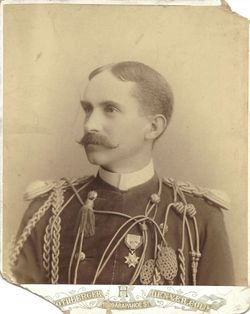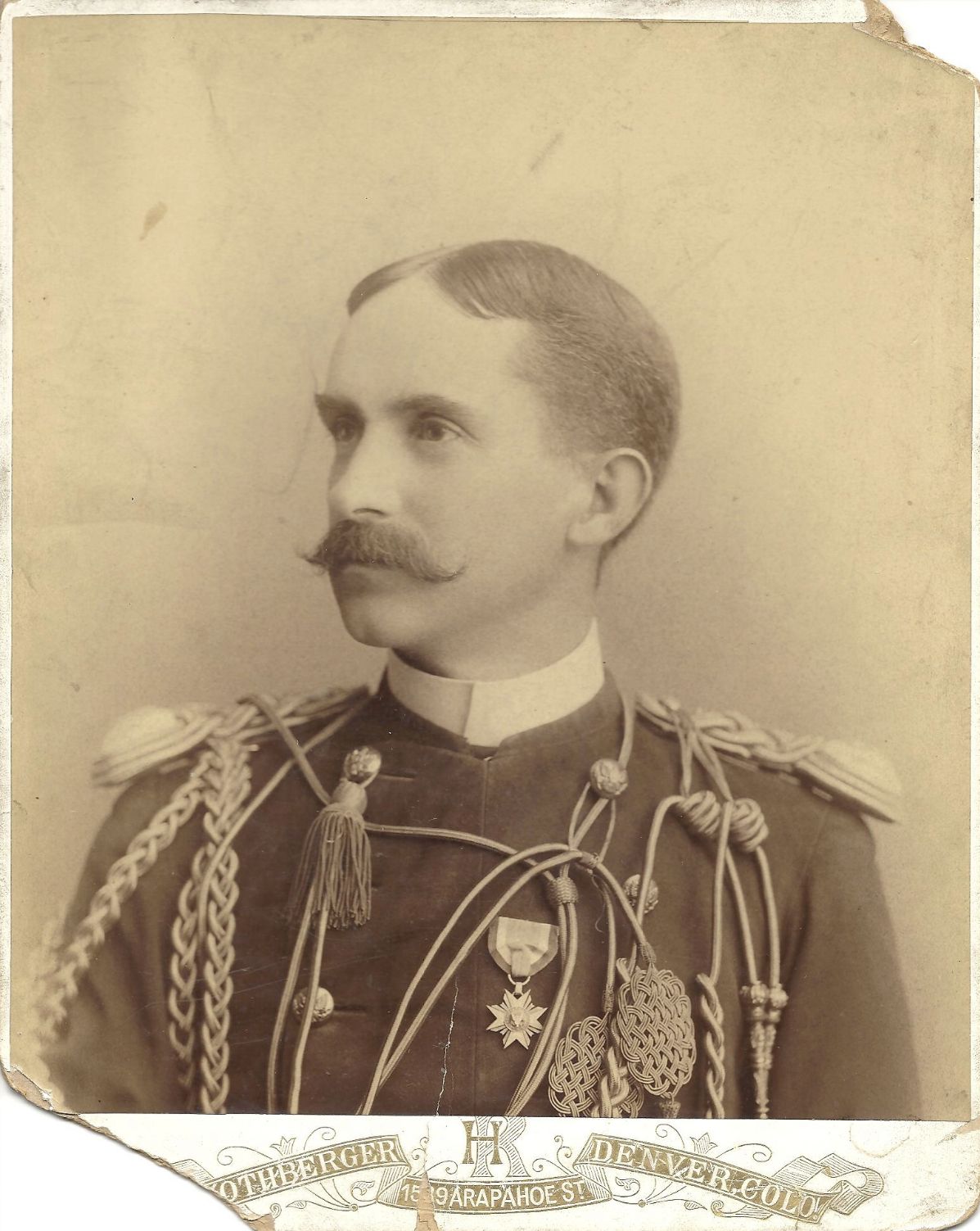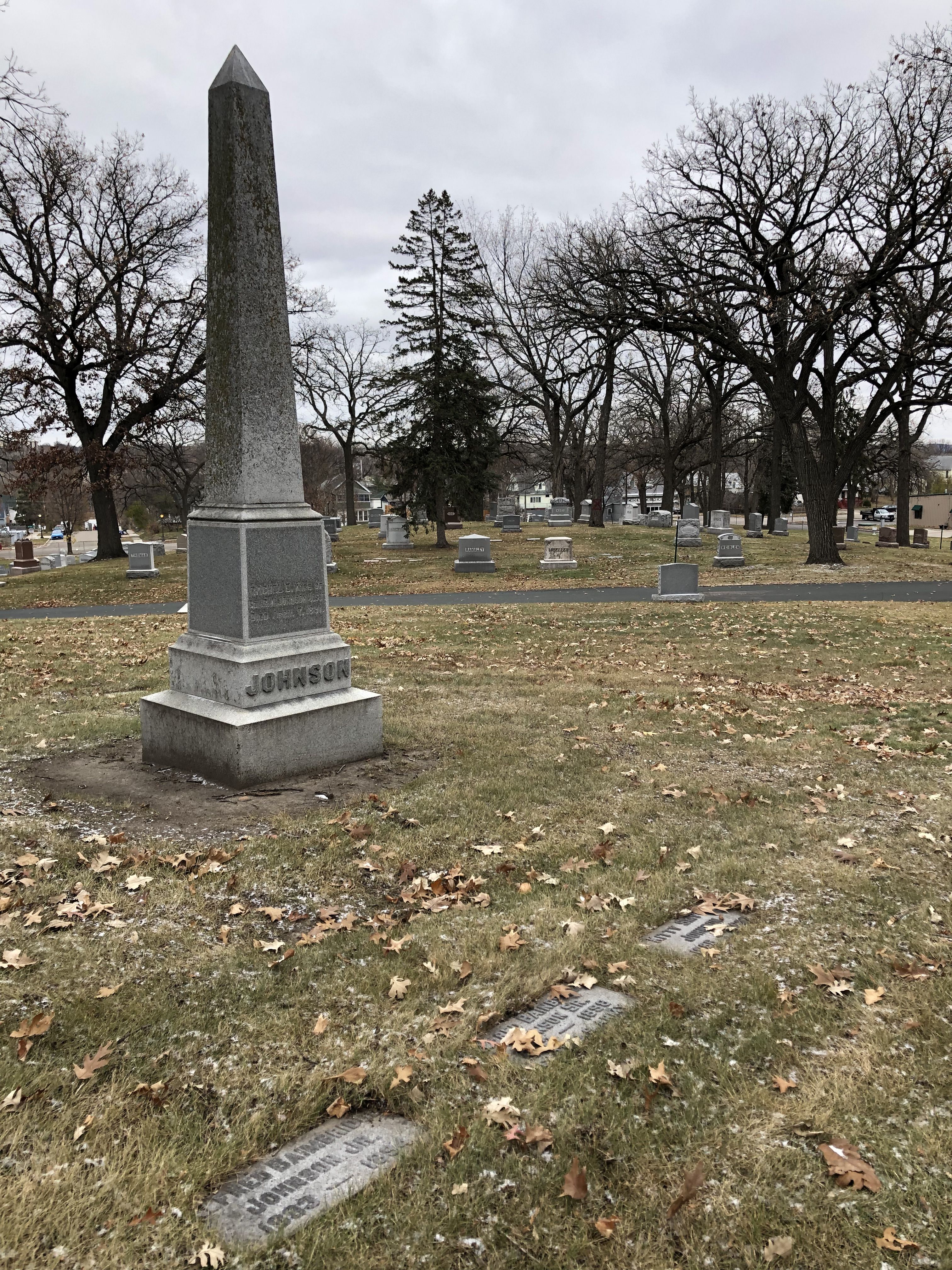Camp Terrett was established to protect travelers between San Antonio and Fort Stockton (and then on to El Paso and points west) from Comanches, although the placement was poorly suited and the camp was soon abandoned for Fort Duncan.
He was named for his uncle (his father's brother) and for one of his father's senior commanders. Bainbridge for Lt. Col. Henry BAINBRIDGE, who was the camp commander (and Richard's commanding officer) at Camp Terrett at the time of the birth of Alfred.
Young Alfred almost perished in a flash flood at the age of six months old. When Camp Terrett was abandoned and the family was traveling to Fort Duncan, a horrific rain came up in the night and swamped the tent that housed his mother, a nurse, and himself. His mother shielded him from the torrent after the storm blew the tent over.
Although born in Texas, he spent a large part of his formative years in the St. Paul, Minnesota area (which was also the headquarters of the Department of Dakota to which the bulk of his career was attached), and considered it his home for the rest of his life.
His uncle was Henry Hastings Sibley, the first governor of Minnesota and prominent founder of that state. Alfred's mother was a sister to Sibley's wife, Sarah Jane, both daughters of General James Steele (commander of Fort Snelling) and his wife Mary (née Hume).
After spending some time at the University of Minnesota in 1870, he graduated from Knox College at Galesburg, Illinois with a Bachelor of Science degree in the class of 1872. He also taught at the University of Minnesota as an instructor (captain of Company "C") in Military Instruction.
Alfred's father had served under Ulysses S. Grant during the Civil War. Also serving with Richard was Benjamin Helm Bristow. Bristow, then Secretary of the Treasury, wrote to Grant on 22 July 1875 asking that he appointed Alfred to the army as a second lieutenant. On 26 July, Grant endorsed this appointment and passed it on the William Worth Belknap, the Secretary of War.
From 1875 to 1882 he was assigned to the Seventh Infantry as a second lieutenant.
During the Battle of the Little Bighorn, in June 1876, 2nd Lt. Alfred was second in command of "I" Company, 7th Infantry, behind 1st Lt. William L. English. The 7th, part of the Montana Column - Department of Dakota, was under the command of Colonel John Gibbon.
On 23 April 1878 he married Katherine "Kitty" SMYTH, the oldest daughter of Henry Martin (H.M.) and Harriet Louisa "Louise" (née GREGORY) Smyth. Kitty was born in Brooklyn, New York on 7 December 1856. Her father feeling ill took refuge first in San Antonio, Texas, and then when the Civil War broke out, Monterrey, Mexico. By 1870 the family had moved to St. Paul. H. M. Smyth founded Smyth Companies, a commercial printer, in 1877, and in 1885 built the house at 466 Portland Avenue, in St. Paul.
Alfred and Kitty had their first child, Katherine Steele JOHNSON, on 15 February 1879.
Alfred is listed on the 1880 USFC as "A. B. Johonson", along with wife Kitty S., and daughter Kitty S., at Fort Snelling, in Richfield Township, just south of Minneapolis.
On 1 May 1882 he was promoted to first lieutenant. He spent time at Fort Pembina just off the Canadian border, Fort Bridger in far off southwestern Wyoming, Fort Fred Steele in south-central Wyoming, and at Fort Logan adjacent to Denver, Colorado. He served as Major General Alfred Howe Terry's aide-de-camp from 1886 to 1887.
Rachel Louise JOHNSON, their second child, was born 22 September 1882.
He was the 7th's regimental adjutant for four years, 1 September 1889 to 1 September 1893, under the command of Colonel Henry Clay Merriam at Fort Robinson in northwestern Nebraska, Fort Laramie, Wyoming, and then Fort Logan.
In 1895 he wrote "The Seventh Regiment of Infantry", a brief history of the 7th up to that point (available online at the Center for Military History), as part of a compilation work titled The Army of the United States Historical Sketches of Staff and Line with Portraits of Generals-In-Chief. (His father authored A Soldier's Reminiscences in Peace and War.)
On 26 February 1892, Alfred Bainbridge JOHNSON, Jr., was born. He would graduate from the United States Military Academy with the class of 1913.
Sometime in 1894 or 1895 Alfred developed inflammation of the kidneys (Bright's disease)
First Lieutenant Johnson, of the Seventh Infantry, was promoted to the rank of captain and assigned to the Fourteenth Infantry, on 21 December 1896.
Soon after assuming his new command he went to San Antonio in an effort to recover his health, but he died of kidney failure there.
His body was returned to St. Paul and taken to the home of his wife's parents, Henry and Louisa Smyth, at 466 Portland Avenue. The funeral service was conducted by Bishop M. N. Gilbert at St. John the Evangelist Episcopal Church (60 Kent Street).
[NOTE 1: The marker says: "1898" for the year of death, but this researcher finds multiple sources that identify the year of death as "1897", and none that say the former.]
[NOTE 2: The name of Alfred's younger brother is Richard Woodhouse Johnson, Jr. Which implies that his father is Richard Woodhouse, Sr. But according to Family Research Group, the "W" stood for nothing.]
[NOTE 3: According to the Family Research Group, quoting a letter from Richard to Rachael on 25 July 1864 from Chattanooga, Tennessee, Alfred had a bad accident of some kind at age 11, and interpreting the verbiage ("...it will be a long time before he will be able to use it."), it appears to be a hand, arm, leg, or foot.]
[NOTE 4: Alfred and Kitty had a fourth child according the 1900 USFC (she states has having four children with three living). I have not been able to pen down the details of this child, although I suspect it was a male that is referenced on some genealogy websites as being Alfred, Jr.; born 1893 and died 1894.]
[REQUEST: If you can add any additional details please leave me a message.]
Camp Terrett was established to protect travelers between San Antonio and Fort Stockton (and then on to El Paso and points west) from Comanches, although the placement was poorly suited and the camp was soon abandoned for Fort Duncan.
He was named for his uncle (his father's brother) and for one of his father's senior commanders. Bainbridge for Lt. Col. Henry BAINBRIDGE, who was the camp commander (and Richard's commanding officer) at Camp Terrett at the time of the birth of Alfred.
Young Alfred almost perished in a flash flood at the age of six months old. When Camp Terrett was abandoned and the family was traveling to Fort Duncan, a horrific rain came up in the night and swamped the tent that housed his mother, a nurse, and himself. His mother shielded him from the torrent after the storm blew the tent over.
Although born in Texas, he spent a large part of his formative years in the St. Paul, Minnesota area (which was also the headquarters of the Department of Dakota to which the bulk of his career was attached), and considered it his home for the rest of his life.
His uncle was Henry Hastings Sibley, the first governor of Minnesota and prominent founder of that state. Alfred's mother was a sister to Sibley's wife, Sarah Jane, both daughters of General James Steele (commander of Fort Snelling) and his wife Mary (née Hume).
After spending some time at the University of Minnesota in 1870, he graduated from Knox College at Galesburg, Illinois with a Bachelor of Science degree in the class of 1872. He also taught at the University of Minnesota as an instructor (captain of Company "C") in Military Instruction.
Alfred's father had served under Ulysses S. Grant during the Civil War. Also serving with Richard was Benjamin Helm Bristow. Bristow, then Secretary of the Treasury, wrote to Grant on 22 July 1875 asking that he appointed Alfred to the army as a second lieutenant. On 26 July, Grant endorsed this appointment and passed it on the William Worth Belknap, the Secretary of War.
From 1875 to 1882 he was assigned to the Seventh Infantry as a second lieutenant.
During the Battle of the Little Bighorn, in June 1876, 2nd Lt. Alfred was second in command of "I" Company, 7th Infantry, behind 1st Lt. William L. English. The 7th, part of the Montana Column - Department of Dakota, was under the command of Colonel John Gibbon.
On 23 April 1878 he married Katherine "Kitty" SMYTH, the oldest daughter of Henry Martin (H.M.) and Harriet Louisa "Louise" (née GREGORY) Smyth. Kitty was born in Brooklyn, New York on 7 December 1856. Her father feeling ill took refuge first in San Antonio, Texas, and then when the Civil War broke out, Monterrey, Mexico. By 1870 the family had moved to St. Paul. H. M. Smyth founded Smyth Companies, a commercial printer, in 1877, and in 1885 built the house at 466 Portland Avenue, in St. Paul.
Alfred and Kitty had their first child, Katherine Steele JOHNSON, on 15 February 1879.
Alfred is listed on the 1880 USFC as "A. B. Johonson", along with wife Kitty S., and daughter Kitty S., at Fort Snelling, in Richfield Township, just south of Minneapolis.
On 1 May 1882 he was promoted to first lieutenant. He spent time at Fort Pembina just off the Canadian border, Fort Bridger in far off southwestern Wyoming, Fort Fred Steele in south-central Wyoming, and at Fort Logan adjacent to Denver, Colorado. He served as Major General Alfred Howe Terry's aide-de-camp from 1886 to 1887.
Rachel Louise JOHNSON, their second child, was born 22 September 1882.
He was the 7th's regimental adjutant for four years, 1 September 1889 to 1 September 1893, under the command of Colonel Henry Clay Merriam at Fort Robinson in northwestern Nebraska, Fort Laramie, Wyoming, and then Fort Logan.
In 1895 he wrote "The Seventh Regiment of Infantry", a brief history of the 7th up to that point (available online at the Center for Military History), as part of a compilation work titled The Army of the United States Historical Sketches of Staff and Line with Portraits of Generals-In-Chief. (His father authored A Soldier's Reminiscences in Peace and War.)
On 26 February 1892, Alfred Bainbridge JOHNSON, Jr., was born. He would graduate from the United States Military Academy with the class of 1913.
Sometime in 1894 or 1895 Alfred developed inflammation of the kidneys (Bright's disease)
First Lieutenant Johnson, of the Seventh Infantry, was promoted to the rank of captain and assigned to the Fourteenth Infantry, on 21 December 1896.
Soon after assuming his new command he went to San Antonio in an effort to recover his health, but he died of kidney failure there.
His body was returned to St. Paul and taken to the home of his wife's parents, Henry and Louisa Smyth, at 466 Portland Avenue. The funeral service was conducted by Bishop M. N. Gilbert at St. John the Evangelist Episcopal Church (60 Kent Street).
[NOTE 1: The marker says: "1898" for the year of death, but this researcher finds multiple sources that identify the year of death as "1897", and none that say the former.]
[NOTE 2: The name of Alfred's younger brother is Richard Woodhouse Johnson, Jr. Which implies that his father is Richard Woodhouse, Sr. But according to Family Research Group, the "W" stood for nothing.]
[NOTE 3: According to the Family Research Group, quoting a letter from Richard to Rachael on 25 July 1864 from Chattanooga, Tennessee, Alfred had a bad accident of some kind at age 11, and interpreting the verbiage ("...it will be a long time before he will be able to use it."), it appears to be a hand, arm, leg, or foot.]
[NOTE 4: Alfred and Kitty had a fourth child according the 1900 USFC (she states has having four children with three living). I have not been able to pen down the details of this child, although I suspect it was a male that is referenced on some genealogy websites as being Alfred, Jr.; born 1893 and died 1894.]
[REQUEST: If you can add any additional details please leave me a message.]
Family Members
Advertisement
Records on Ancestry
Advertisement
















